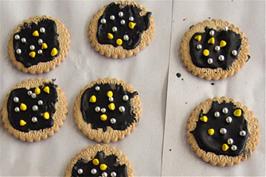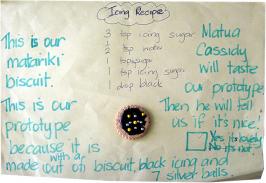Celebrating Matariki – Unit plan
Overview
Year 1 – Students working towards achievement at Level 1
Teacher: Lou Reed, Te Kura o Otangarei
Global intention: We are going to design biscuits to help us celebrate Matariki not only for our class but for the whole school and attempt to understand technological modelling
Dates: The rising of Matariki, or the star cluster known as Pleiades, usually occurs near the end of June and the beginning of July, marking the start of the Māori New Year.
Curriculum links
| Values:
| Key competencies:
|
| Technological practice | Nature of technology | Technological knowledge |
| Planning for practice
| Characteristics of technology
| Technological modelling
|
| Brief development
|
Characteristics of Understand that technological outcomes are products or systems developed by people and have a physical nature and a functional nature. | Technological products
|
| Outcome development and evaluation
| Technological systems
|
Learning outcomes and success criteria
Context learning outcome
We are learning: What Matariki is and ways that we could celebrate Matariki at school.
We know we have achieved this when we can: Explain what Matariki is, and why it is important to celebrate.
Curriculum learning outcomes and success criteria
| We are learning to: | We know we have achieved this when we can: |
| Describe to others what we are doing and what attributes our final outcome has to have. (BD) | Describe an image that will represent Matariki and be suitable for using on the top of a biscuit. |
| Develop different design ideas and test these against the attributes our final outcome has to have. (ODE) | Develop models of our design ideas and share these with the class so we can all agree on a design that best meets the brief. |
| Develop and test a prototype, and make the final outcome. (ODE) | Make a biscuit (prototype) based on the selected design and ask Matua Charles for his opinion. Make a batch of biscuits that are all the same design and quality for the celebration lunch. |
| The difference between a model and a prototype and how they help future decision making. (TM) | Make models to test our design ideas (name as models). Make a one-off outcome to test before making more. Call this our prototype. Explain the differences in terms of how each model helped us to decide what to do next. |
Formative assessment
| Diagnostic assessment | Assessment task |
| Brainstorm on what we know about Matariki and how it could be celebrated |
Lesson outline
| Week | Activity |
| Week 1 |
|
| Week 2 |
|
| Week 3 |
|
Assessment
| Summative assessment:
| Formative assessment:
|
| Reflection on unit: The unit was a bit rocky to start of with but once I got my AO's aligned with my learning intentions and lesson progressions it went very well. The children were highly motivated and I think this was due partly to me being very motivated. I understood as I progressed through. Planning and preparation: I feel I needed to actually analyse the AO's a lot closer as I found that I could move freely from one AO to the other. Once I understood, there was no stopping me. The preparation has been to purchase the ingredients for the biscuits tops, the materials so the children could brainstorm and record their results in their groups and really thinking every step through so that I could move the children through at a good pace." Catering to individual students' needs: Extend the more capable like Nicholas, Nancy Rose, Petera, Jayden and give Taylor the opportunity to step into roles of responsibility. Challenging all students: I would like to see the quieter members of the class taking an active role in the various roles. Use of class time: Three half hour sessions three times a week for three weeks. Overall delivery: I was pleased with the outcome and all the children were able to explain and show in their own way their understanding.
Success of unit based on assessment and anecdotal observations:
Areas for future improvement (what would have worked better): |
|


